Part 1
AUTOCAD INTERFACE AND PRELIMINARY SETTINGS
I will give to assume that the program is already installed on your computer and ready for use.
If you do not have the program you can download a trial version from Autodesk's website at:
http://usa.autodesk.com/adsk/servlet/pc/index?siteID=123112&id=13706332
When you start Autocad will be presented with a window similar to the one below.
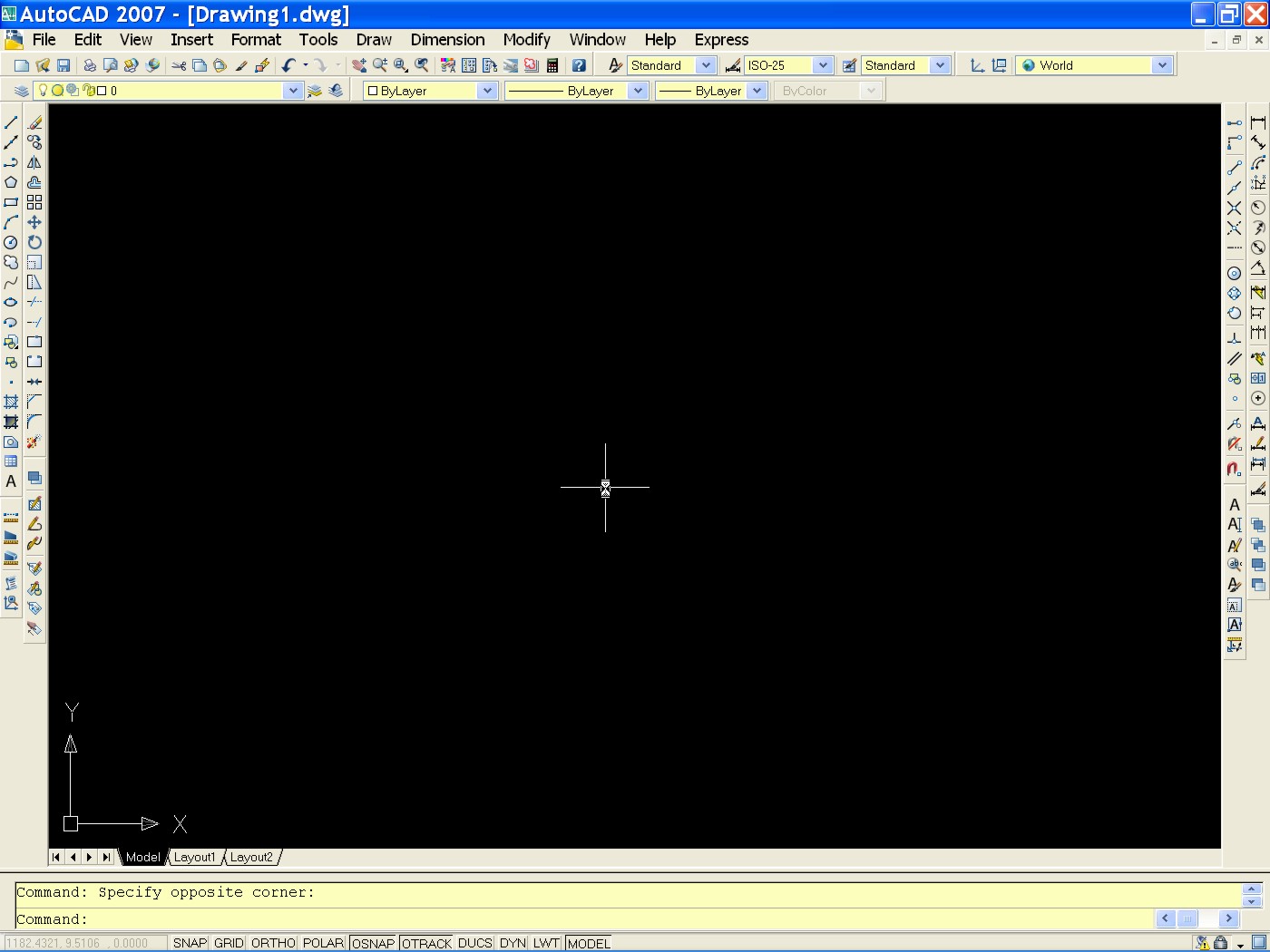
And here is our program, you see similar to almost all Windows programs comes with a row of pop-up menu at the top with the commands "file, edit, view, insert" and so on.. , and several "toolbars" . All those buttons, which correspond to various commands that we will see below, are divided into groups, the "toolbars", which can be customized to make them visible or invisible, and move into desired position.
In the picture above this interface has already been partially done, so you might see things arranged differently from how have you on your screen.
Do not worry about it for now, also depending on the version of Autocad, icons may look slightly different, but basically the symbols represented at least for the main controls are the same.
Then we have the central area, that the drawing area (usually a black background), with the center of the cursor or " crosshairs " controlled by the mouse.
In addition to this in the bottom left, still in the drawing area, you should see an icon with two arrows and the letters X, Y
This is the icon called "UCS" and represents the coordinate axes X, Y on which you move the crosshairs.
A large part of very important and I ask you to remember is the "command line" , which is the window at the bottom on two or more lines at the bottom where you see write "command:".
It 's very important especially in the beginning you get used to observe what is written in this window when you run the command,Autocad every time you use a command here shows you the steps to run it.

Introduction to "Toolbars"
Well, back to the "toolbar" and see the first two to be taken into consideration.
The "draw" toolbar

And the "modify" toolbar

Ideally they should already be visible to the sides of the canvas, perhaps a right, left and arranged vertically.
If not, move the pointer over any button of the toolbar and click on this with the RIGHT CLICK of mouse, will bring up a menu like the one shown in the picture.
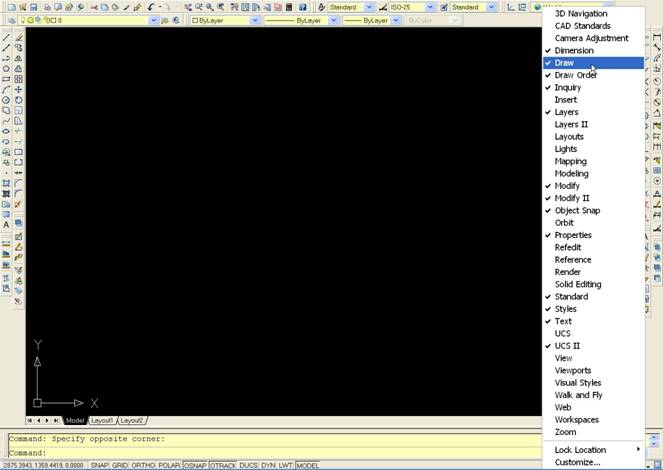
The entries in this menu correspond to the various "toolbar" visible and invisible, and as you have probably realized by this entry can be enabled or disabled.
Click on the items "draw" and "modify" to make this toolbar visible.
When they appear in the drawing area you can move by clicking and holding the button on its top in blue and drag them (one at a time) on the left side of the screen, at some point you'll see that you will have automatically vertically, then Release the mouse button .
In this way, you can customize the interface of the program as desired by activating the toolbar that you use frequently and placing them where you want it, on right, at the top left or above the drawing area etc.
Preliminary Settings
Before you start drawing we see a couple of other things.
Click your mouse on the menu "Tools"> "Options .." as in the image below.

You'll see a window containing a number of tables from which you can set a whole series of things such as background color, the command line, and other parameters that affect the operation of the program.
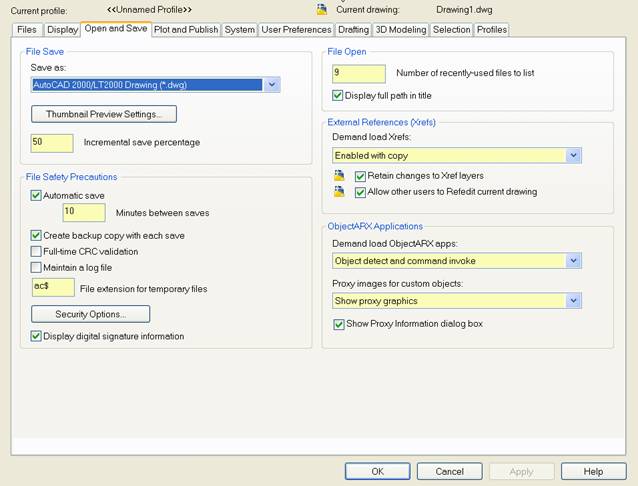
Ok, now click the "Open and Save" and under the "save as" open the popup menu by clicking the arrow to the side.
It's the one highlighted in blue in the previous image...
In this menu you'll see some entries with the words:
AutoCAD2007 drawing (*. dwg)
AutoCAD2004 drawing (*. dwg)
AutoCAD 2000 Drawing (*. dwg)
etc..
These entries written on the side (*. dwg) represent the types of files that our program can open and save. More specifically, for example by setting this item to "AutoCAD 2000" set Autocad that every time you save a drawing that we did or we open, it is saved in AutoCAD 2000 format.
What does this mean?
As you might know there are different versions of AutoCAD and comes out every 1-2 years a new, the latest "release" is the 2015.
(Of this, like the previous ones, there is a version LT (light) and the normal, full.The light version does not have the ability to create designs in 3D (three dimensional), but can open and view them, while with the most comprehensive and expensive full version can be created through tools and additional commands).
The most important difference between the "release" of program is that older versions can not open drawings created by the later versions, unless those who have saved the file has not set his program for saving in a old version, as explained before.
This is very important to know especially when collaborating with other users and you have to give or receive drawings.
Beyond this, every file saved from AutoCAD will be of type "dwg", the files as normally autocad manage have "dwg" extension.
For example, if we save a drawing and call it "Plan" or "kitchen" will be automatically saved in this way:
plan.dwg
kitchen.dwg
Where the point. separates the filename from its extension, which identifies a file type to another.
There are indeed many types of files with many different extensions:
"Pianta.doc" would be a text document
"Pianta.bmp".Gif, .Jpg, .Tiff and others, would rather the images.
I digress a bit 'from Autocad but if you're not already aware, this information will be useful.
The "dwg" however, is not the only type of file that can be read and saved from AutoCAD, but we will see this later.
Then return to the Options window of Autocad, and always in the "open and save.
look further down the "Automatic Save" (Auto-Save), which should already be enabled, and the window of the "Minutes Between saves" (Minutes of each save) type such as 10.
In this way, Autocad perform an automatic save every 10 minutes the drawing you're working on, and put it in a specific folder.
This feature is very useful for not losing your work as you'll see that sometimes the program crashes, or leaves the current or accidentally delete the file you were working.
You will then be possible (and useful) to go back to the file that was saved in AutoCAD automatically, as we shall see ....
We are now going to set the right click of the mouse.
Also in the options window, click on the table "user preferences (user preferences) and then again click on the button at the top left" right-click customization (customization right mouse button).
In the window that appears, activate the first box for each item, click on it for the following items.
-Default mode, edit mode, command mode-
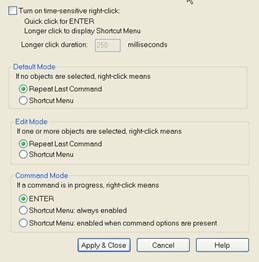
According to the release of AutoCAD you have, you can alternatively check the first entry is in the window, turn on time-sensitive right click.
Finally, click on "Apply & Close".
In this way, clicking the right mouse button, after completing a command, AutoCAD will repeat it.
If you just finished drawing a line for example, after clicking the right button will be repeated the command "line", and so for all other commands.
This feature helps a lot to speed up the work, accustomed to use it, during the course you'll often put into practice.
On the Table "display" click on the "colors" , will open the window you see below on which to set the colors of the program interface.
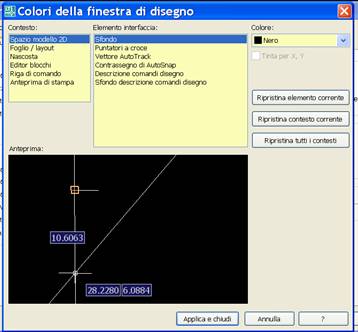
On this window select the central area at the top, the first item in the "background" and then open the color menu on the right and select the desired color for the background. Usually used black.
After click "apply and close" to assign changes made to the colors.
Now click "OK" at the bottom of options window, to close it and accept the changes.
What has been said so far are general settings to be done only once, the next time you open AutoCAD will not need to repeat them.
If Autocad crashes before you have it closed and reopened, the settings will be lost as they are made.
SUMMARY:
Open Autocad, customize the interface and activating the toolbar and fixed to the screen. (We have seen thus far, "draw" and "modify").
Open the Options dialog from the "tools> options .." and set the auto-save, if necessary set the save to older versions. (For the moment leave it as it is with the default setting).
Also in the options dialog set preferences for the right mouse button, the table "user preferences."
From the chart "display options" if you prefer set the background color to black.










No comments:
Post a Comment